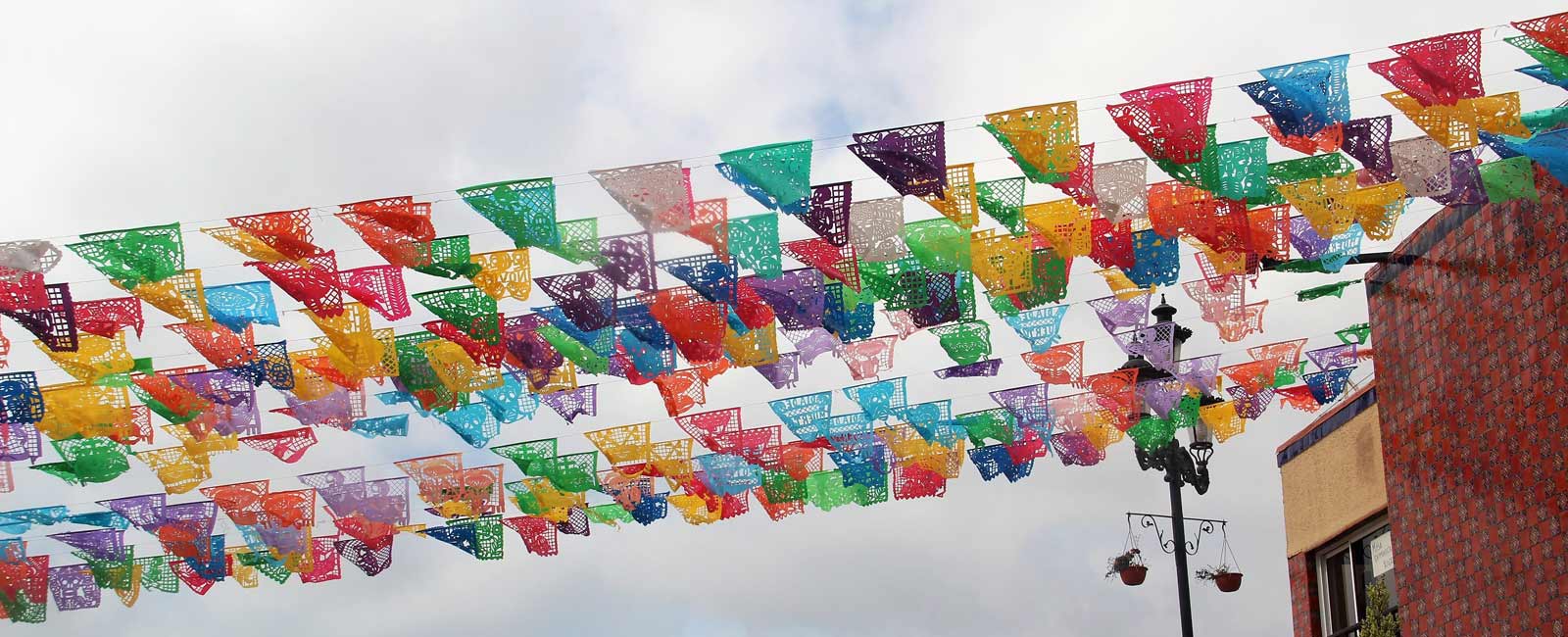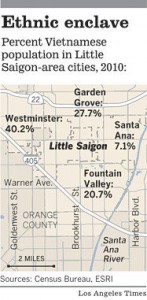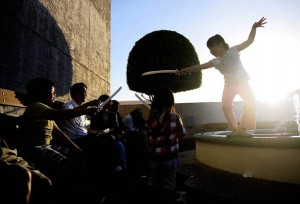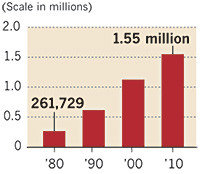Experiential Learning: Vietnam in Southern California
Southern California Teachers: Want a nice complement to your inter-cultural studies? Vietnam War unit? Human Geography field work? Here’s a fun educational field trip destination with activities in Little Saigon, an established Vietnamese community easily accessible off the 405 freeway.
Preparations needed: Bus transportation for students and chaperones: 3-5 hours during late morning to early afternoon. $10.00 for lunch, $5.00 for market activity. Vietnamese phrases hand-outs. “Interview a local” Worksheet. Students need to bring a notebook and pencil.
Plan to spend the late morning and early afternoon in Little Saigon. On the bus ride, distribute basic shopping phrases in Vietnamese, and practice saying them out loud with the students (See Wiki Travel Phrasebook: ). Tell the students that you will walk together through the neighborhoods, visit key areas of local commerce (Post office, pharmacy, markets, etc) and then eat an authentic lunch. At lunch, the students are to identify one ingredient in their meals – an herb, vegetable, spice, root – anything unique. They must ask the wait-staff (or other diners) the English and Vietnamese name for this ingredient. The next challenge (after lunch) will be to break into pairs and bargain for this ingredient —using as much Vietnamese as possible—in the local marketplace. They must find a way to purchase as much of this ingredient as they can get for $5.00. Upon meeting at the designated time / place following the activity, students will share stories of their experiences with a quick-write in their notebooks: What did they observe? How do these markets differ from those where they usually shop? Teachers may choose to collect all the ingredients for a follow-up Vietnamese food cooking project at school or donate the produce during the next activity: personal interview with a local merchant. People here are friendly and enjoy talking to visitors. Break students into groups of four, give each of them a destination from your earlier walk (post office, pharmacy, etc) and a “Interview a Local” worksheet. Students should be encouraged to brainstorm additional interview questions to ask local proprietors, and be respectful with their journalists’ task. The goal is to understand the way these Vietnamese people live and do business as naturalized Americans. Follow-up with sharing of answers and group discussion on the bus-ride home and in the classroom.
Assign as pre-or post -reading: The LA Times cover story, June 18, 2013, honors the 25 year anniversary of Little Saigon. Inextricably linked to the mass migrations following the end of the Vietnam War, the rise of Little Saigon has much to teach us about the Vietnamese culture, their family networks and what cultural gems are possible when hard-working people live in a state of peace, instead of war.
Photo-essay: http://framework.latimes.com/2013/06/18/little-saigon/#/0
Nghien Tran, 113, prays during a Mass being said at St. Barbara’s Parish in Santa Ana. Tran has been a member of the church since 1980 when she moved from southern Vietnam to the United States. She has 10 children, 55 grandchildren and 80 great-grandchildren.
In 1988, an off-ramp sign on the Garden Grove Freeway marked the official birth of Little Saigon in Orange County. Now, as Vietnamese Americans toast 25 years of an enclave once sprinkled with orange groves and strawberry fields, the immigrant community spans beyond Westminster into Santa Ana, Fountain Valley and other neighboring cities.
As Little Saigon turns 25, family and heritage mark the path ahead,
In a conservative Orange County town, where the strawberry fields were still plentiful and the population solidly white, Danh’s Pharmacy stood out when it opened its doors after the Vietnam War came to an end.
Yet the business was just the beginning in a small Orange County city that would quickly balloon into a bustling immigrant community.
When Danh N. Quach chose to set up shop in 1978 in Westminster, he knew just one Vietnamese doctor — the same man who agreed to co-sign a loan for him.
PHOTOS: Little Saigon turns 25
Now, as Little Saigon celebrates its 25th anniversary — a date marked not by the arrival of refugees, but by the state erecting a freeway offramp sign — Quach’s shop stands as a landmark in the largest Vietnamese cultural district outside the country itself.
The streets bustle with noodle houses, produce markets, jewelry shops and bakeries. The enclave sprawls into neighboring cities. Local government is dominated by Vietnamese American politicians, and senators and presidential candidates swoop by during election seasons, looking for votes. More than 300,000 people of Vietnamese descent live in the county, according to area officials.
The second generation has dutifully stepped in to run many of the pioneering businesses in the area, growing them with the principles and practices they learned in American schools. But there’s uncertainty whether the trend will hold and whether — as the decades pass — Little Saigon will remain Little Saigon.
As with many other first-wave immigrants, Quach set a path that his children followed. His eldest son’s medical offices are next door to his business, his daughter owns a pharmacy nearby, and his youngest just graduated from medical school and probably will be expected to practice in Little Saigon. Even his wife manages her own pharmacy across the street from her husband.
“Papa saved a piece for me,” said obstetrician Thomas Tri Quach, 47. “The question is, how will we attract the next generation to Little Saigon? Will they want to work as close to their family as I do?”
Danh Quach had been a pharmacist in Saigon until war brought him to America as a refugee. When he opened shop on Bolsa Avenue in Westminster, he dispensed medicine, tobacco, shampoo, boomboxes, fabric — items that new immigrants in the community sought out to mail to loved ones left in Vietnam.
He sold care packages for $100 to $300, and Air France stopped by twice a week to pick up the shipments through a government program that allowed refugees to send “humanitarian aid” to family members.
In the early years, Quach worked seven-day weeks. He typed prescription labels in Vietnamese, delivered orders until 10 p.m. because not many of his customers owned cars and then stayed to hear about their lives.
He learned to keep careful records, in contrast to Vietnam’s system where patient information was not often saved, and laws were so lax that cashiers were permitted to sell drugs. When Orange County health workers began testing for tuberculosis, his business spiked as customers poured in for medication.
At the time, real estate in central Orange County was going for 50 cents a square foot, a fraction of today’s cost. Quach and partner Frank Jao, the man frequently credited with developing much of Little Saigon, began buying space in strip malls, including the center where thousands staged nightly demonstrations in 1999 after a video shop owner put up a photo display of Communist leader Ho Chi Minh.
Quach now owns about 300,000 square feet of retail space through real estate partnerships in Little Saigon, a mecca luring Vietnamese expatriates from around the world.
“At first, we thought Little Saigon might last 20, 25 years. We were wrong,” Quach said. “I think Little Saigon is here to stay. Mom and Dad might be the tenants, and when they retire, they will pass it on to their children.”
Tam Nguyen, who heads the 1,500-member Vietnamese American Chamber of Commerce of Orange County, said it’s become a trend for children to take over and expand the businesses of Little Saigon. He and his sister inherited their parents’ successful Advance Beauty College in Garden Grove, which started in the ’80s.
“We in the younger generation are mainstreaming it — looking for customers outside the normal pool and using practices picked up in MBA school and adapting it with older traditions,” Nguyen said. “The goal is to improve so we can continue what our elders gave us.”
Growth
Vietnamese population growth, U.S., 1980-2010
Source: Census Bureau
Data analysis by Ben Welsh
For Quach, his entire family is in the pharmacy or medical business, and all but his younger son, who is completing his residency in Los Angeles, live in the same housing tract not far from where his original store stands.
“No pressure for my brother,” Thomas Tri Quach said, laughing. “Papa is still open-minded.”
The family patriarch, now 74, said he’s driven by a basic belief: “If you focus on one thing — that’s service to your community — then that community can sustain. It will always be there.”
His daughter, pharmacist Thuy-Linh Nguyen, agreed.
“I think of Little Saigon like a child,” she said. “She needs our unity, love, dedication. What we’ve tried to do is put less of the ‘I’ and more of the ‘we’ in the picture. The young people can make it better with teamwork.”
Danh Quach remembers bringing ramen to eat at work in the early days — “I didn’t have restaurants to choose from.” No longer.
“I walk out my door and the whole of our Vietnamese world is waiting. Little Saigon does not lack for anything.”
By Anh Do
Source: http://www.latimes.com/news/local/la-me-ff-little-saigon-birthday-20130619,0,4912996.story



